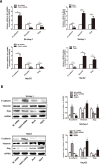TRAF4 Regulates Migration, Invasion, and Epithelial-Mesenchymal Transition via PI3K/AKT Signaling in Hepatocellular Carcinoma
- PMID: 28256185
- PMCID: PMC7841052
- DOI: 10.3727/096504017X14876227286564
TRAF4 Regulates Migration, Invasion, and Epithelial-Mesenchymal Transition via PI3K/AKT Signaling in Hepatocellular Carcinoma
Erratum in
-
Erratum.Oncol Res. 2020 Dec 10;28(5):559-560. doi: 10.3727/096504020X16032056440102. Oncol Res. 2020. PMID: 33349309 Free PMC article.
Abstract
Overexpression of the tumor necrosis factor receptor-associated factor 4 (TRAF4) has been detected in many cancer types and is considered to foster tumor progression. However, the role of TRAF4 in hepatocellular carcinoma (HCC) remains elusive. In this study, we found that TRAF4 was highly expressed in HCC cell lines and HCC tissues compared with normal liver cell lines and adjacent noncancerous tissues. TRAF4 overexpression in HCC tissues was correlated with tumor quantity and vascular invasion. In vitro studies showed that TRAF4 was associated with HCC cell migration and invasion. An in vivo study verified that TRAF4 overexpression facilitated metastasis in nude mice. In addition, overexpressed TRAF4 promoted the phosphorylation of Akt and induced Slug overexpression, leading to downregulated E-cadherin and upregulated vimentin, while silencing TRAF4 moderated the phosphorylation of Akt and repressed the expression of Slug, which resulted in upregulated E-cadherin and downregulated vimentin. These effects were inversed after pretreatment of the PI3K/Akt inhibitor LY294002 or overexpression of constitutively active Akt1. Our study demonstrated that TRAF4 was involved in promoting HCC cell migration and invasion. The process was induced by the EMT through activation of the PI3K/Akt signaling pathway.
Conflict of interest statement
The authors declare no conflicts of interest.
Figures





References
-
- Maluccio M, Covey A. Recent progress in understanding, diagnosing, and treating hepatocellular carcinoma. CA Cancer J Clin. 2012;62(6):394–9. - PubMed
-
- Llovet JM, Burroughs A, Bruix J. Hepatocellular carcinoma. Lancet 2003;362(9399):1907–17. - PubMed
-
- Siegel R, Naishadham D, Jemal A. Cancer statistics, 2013. CA Cancer J Clin. 2013;63(1):11–30. - PubMed
-
- Carr BI. Hepatocellular carcinoma: Current management and future trends. Gastroenterology 2004;127(5 Suppl 1):S218–24. - PubMed
-
- Zhu AX. Systemic therapy of advanced hepatocellular carcinoma: How hopeful should we be? Oncologist 2006;11(7):790–800. - PubMed
MeSH terms
Substances
LinkOut - more resources
Full Text Sources
Other Literature Sources
Medical
Research Materials
Miscellaneous
